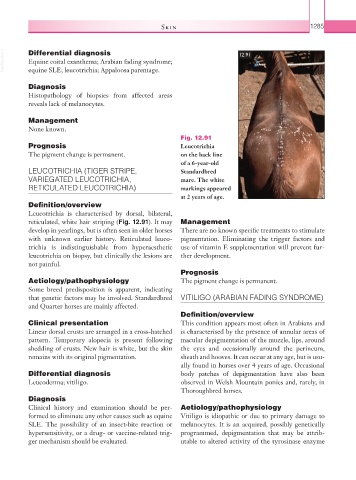Page 1310 - Equine Clinical Medicine, Surgery and Reproduction, 2nd Edition
P. 1310
Skin 1285
VetBooks.ir Differential diagnosis 12.91
Equine coital exanthema; Arabian fading syndrome;
equine SLE; leucotrichia; Appaloosa parentage.
Diagnosis
Histopathology of biopsies from affected areas
reveals lack of melanocytes.
Management
None known.
Fig. 12.91
Prognosis Leucotrichia
The pigment change is permanent. on the back line
of a 6-year-old
LEUCOTRICHIA (TIGER STRIPE, Standardbred
VARIEGATED LEUCOTRICHIA, mare. The white
RETICULATED LEUCOTRICHIA) markings appeared
at 2 years of age.
Definition/overview
Leucotrichia is characterised by dorsal, bilateral,
reticulated, white hair striping (Fig. 12.91). It may Management
develop in yearlings, but is often seen in older horses There are no known specific treatments to stimulate
with unknown earlier history. Reticulated leuco- pigmentation. Eliminating the trigger factors and
trichia is indistinguishable from hyperaesthetic use of vitamin E supplementation will prevent fur-
leucotrichia on biopsy, but clinically the lesions are ther development.
not painful.
Prognosis
Aetiology/pathophysiology The pigment change is permanent.
Some breed predisposition is apparent, indicating
that genetic factors may be involved. Standardbred VITILIGO (ARABIAN FADING SYNDROME)
and Quarter horses are mainly affected.
Definition/overview
Clinical presentation This condition appears most often in Arabians and
Linear dorsal crusts are arranged in a cross-hatched is characterised by the presence of annular areas of
pattern. Temporary alopecia is present following macular depigmentation of the muzzle, lips, around
shedding of crusts. New hair is white, but the skin the eyes and occasionally around the perineum,
remains with its original pigmentation. sheath and hooves. It can occur at any age, but is usu-
ally found in horses over 4 years of age. Occasional
Differential diagnosis body patches of depigmentation have also been
Leucoderma; vitiligo. observed in Welsh Mountain ponies and, rarely, in
Thoroughbred horses.
Diagnosis
Clinical history and examination should be per- Aetiology/pathophysiology
formed to eliminate any other causes such as equine Vitiligo is idiopathic or due to primary damage to
SLE. The possibility of an insect-bite reaction or melanocytes. It is an acquired, possibly genetically
hypersensitivity, or a drug- or vaccine-related trig- programmed, depigmentation that may be attrib-
ger mechanism should be evaluated. utable to altered activity of the tyrosinase enzyme

